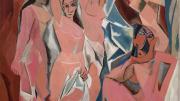One may ask what more could possibly be said about Les Demoiselles d’Avignon, one of the most thoroughly analyzed works of art, ever. But Suzanne Preston Blier, Clowes professor of fine arts and professor of African and African American studies, has brought fresh eyes, new evidence, and a diverse set of research disciplines to bear on the work, resulting in Picasso’s Demoiselles: The Untold Origins of a Modern Masterpiece (Duke University Press, $29.95). The masks he depicted provide one clue to her interest: Blier has published broadly on Africa’s art and architecture. After recounting her personal journey toward this analysis, and the methods she employed, her introduction begins briskly:
Most scholars today see Pablo Picasso’s iconic painting Les Demoiselles d’Avignon as a work about five prostitutes who boldly stare down their male bidders, a theory rooted in part in Picasso’s purported discomfort with women. The latter tensions are thought to be reflected in the strange African masks that several of the figures wear. It is hard to imagine that a work of this complexity, one that Picasso labored on for more than five months, had such a porous and, indeed, insecure foundation.…I reveal instead that the painting is richly layered, multivalent, and far more interesting. My reading sees these figures not only as sexual beings but also as mothers, grandmothers, lovers, sisters, and both family and race progenitors—in short as women more broadly defined in their myriad roles. This is based in large part on an array of new evidence that has escaped scholars to date, materials that inspire new questions about the painting. Through these sources I have broadened the painting’s purview considerably, expanding it from its narrow brothel setting and transforming the five occupants into global women of multiple eras and identities. This reading is consistent with the larger colonial world Picasso and his friends inhabited, as well as core interests of the period in terms of both evolution and ideas of origin.…
Picasso likely did not want the fact the he was using book images to be known for fear they would harm his growing reputation. Even later, when his reputation as a revolutionary artist was secure, he likely made sure that none of these materials saw the light of day. Today, we know that Gauguin, Matisse, and other artists of the era used illustrated books, journals, and photographs as sources, yet until very recently the use of published works of this type was seen to be problematic. This legacy of disparagement no doubt made Picasso’s sources difficult to address, much less admit, and if this meant that basic questions were unanswered, so be it.









